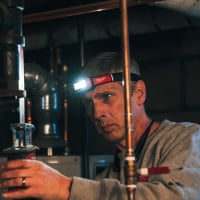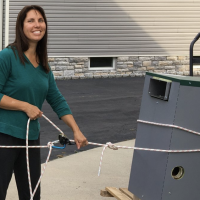Steam-one boiler or two, and, Atmospheric vs Gun

Hi all, I'm a part-time landlord. Looking at two 8-units. Both heat with oil
One Building has a 1970s (I am guessing) Weil McLain (it looks tired, a side panel was off, apparent corrosion)
The other has (two) year 2000 or so smaller oil boilers.
To add to the whole mix, there is nat gas on the property, so that would be a plus
If you had your choice, is there any advantage of two smaller boilers vs one normal-sized boiler? I presume if one boiler drops out, there's not enough capacity to fill the mains/system. Maybe it's better than no heat at all? OR, they little fellas can actually handle the entire loan and it's lead lag. I'll have to do some math
I don't have total EDR at this moment, I will return the the place and get one apt. measure up and multiply by 8. The question is more based on 1 vs 2.
Question 2- if you have modern oil tanks on site, but you prefer nat gas, might you consider installing oil-type boilers with gas guns? (I know I'll get comments about leaving unused oil tanks)
Thanks
Comments
-
-
Using 2 boilers with Steam, you will most likely have both boilers start at the same time and produce enough steam to get the pressure up to about 3/4 of the operating pressure then have a boiler drop out. The other boiler will keep operating until the call for heat is satisfied. If the one boiler can not keep the pressure high enough because the load is greater (because the outdoor temperature is lower and the radiators can't keep up with the amount of heat needed in the rooms) then the second boiler will cut back in if the pressure drops.
Another way is to operate only one boiler when with an outdoor temperature sensor in series with the other limits.
The best way is with a Heat Timer staging system with a little more logical inputs that take into consideration several inputs like outdoor temperature, boiler pressure, and cycle timing.
Two boilers are usually more economical to operate and sometimes less costly to maintain since you are using lower price boilers and parts. Sometimes there is an economy of scale with performing two maintenance procedures without moving your tool box and truck to another customer so the actual maintenance per boiler is less expensive.
With Hot Water the answer is easier. It is definitely more efficient to use two boilers.
Edward Young Retired
After you make that expensive repair and you still have the same problem, What will you check next?
2 -
Its alot more $$ & piping to do two boilers....it's got distinct advantages, but..…Mad Dog
2 -
I agree Ed..HW systems are a natural..Remember the Slantfin Caravan systems? Many large Residential apartments buildings are heated with them..Mad Dog
0 -
It does take a lot more piping to make two boilers work on steam if run at the same time. Two boilers with manual changeover is ok. But to work automatically controlling condensate and water level is a issue. With 2 boilers you usually size them for 80% of the load. can probably go less. With 2 boilers the idle boiler fills with condensate as it acts as a condenser so now you need overflow traps and a feed tank. fed water isolation valves and controls. It gets $$$$
I would stay away from 2 unless size is an issue its a lot more work.
That said 2 will be more economical to run but more install $$$ and more maintenance.
3 -
-
I measured one apartment today, about 140 EDR.
Times 8 = 1120
0 -
-
this is the other building
this one’s a little bit more aged
these boilers have much more capacity than the basic math I came up with0 -
I'm not sure I see replacing either as economical. The newer ones you could put gas power burners on and replace when they fail individually, maybe put some better staging controls on them that will let you replace the boilers and connect to the existing controls when they do fail. If your balance is good it should still heat at a lower capacity with one boiler. If it does not you could close some radiator valves to reduce the system capacity until you can replace a failed boiler. I suppose it deserves better scrutiny to see if the 2 boilers were piped properly but it looks like whoever did it at least thought they knew what they were doing.
The welded header should have some threaded swing joints added at replacement so it isn't trying to pull the boiler apart but it seems to have held this long.
I thought that tank was for condensate management but looking more closely it is a shell and tube hx for either dhw or more likely a hot water loop.
2 -
yes that's for DHW, it's actually sending two pex lines to the opposing building and heating that water heater as well. That took me a few minutes to figure out! (all the piping is insulated, and I never thought Building A would send a water loop underground to building B)
The Ole boiler has its left cover off and it's looking kinda crusty.
0 -
If I remember correctly, that left side with the cover off is where the flue cleanout covers are located. that crusty may just be furnace cement to keep the covers from leaking flue gas out by the poorly fitted covers. you can get replacement rope gasket material for those covers and scrape off all the furnace cement. Then it will look like new. If you have a missing or cracked clean-out cover, there are replacements available.
Those 3 boilers may not need to be replaced. All you need for the 78 boiler is a gas power burner with the proper input capacity. Some of them came with oil burners other with gas burners and even others with combination gas/oil burners. So nothing special needed there
For the two SGO boilers, you can also get gas guns with the proper input capacity that will work just fine. You want to get fancy? Leave one of the burners oil and get one gas gun. That way when one fuel is more economical than the other you can use that boiler as the primary. If the other fuel becomes more economical in the future, then swap to the other boiler as the primary. The poor man's duel fuel system.
Edward Young Retired
After you make that expensive repair and you still have the same problem, What will you check next?
3 -
The pic with 2 boilers bothers me. I may not sleep tonight.
How is the header draining? It can't go back into the boilers that's for sure. I don't know if the flange on the right going through the brick wall if that is connected to the header?? Looks like a small copper pipe coming out of the bottom of the pipe going through the wall but that pipe if connected to the header is reduced so the header is 1/3 full of water.
Looks like an Everhot external tankless water heater laying on its side.
There is a common pressure control on the main header probably running both boilers on pressure.
1 -
Looks like it is dripped with an offset connection to the flange with a 3/4" copper pipe. how the 5 vaporstats/pressuretrols are connected is a great question. how it manages condensate between the boilers is also a good question.
0 -
yes the header is draining into the return through that dinky 3/4 line. I also saw some "ole medium' knee-high return mains in the basement. Kinda curious how the A dimension isn't bucking up a small storm.
On the 'double boiler', you can see one of the returns coming in from behind the ladder. The opposing return comes in from the opposite direction, behind the boiler, same general height.
0 -
Not that you asked but according to many people on this site and at least a few low pressure steam boiler manufacturers, all three boilers should not have lasted with the near boiler piping. We see boilers piped in similar fashion often and they often last a long time despite the welded piping. The best example may be the Weil McLain 78 with the steel welded risers welded directly to the header. There is certainly no room for expansion, no flanges, no swing joints, etc. Despite the piping, the boiler appears to have lasted roughly twenty five years. For the record, Weil McLain made the 78 series from 1993 through 2002.
With regard to your question(s), I would not install a gas power burner in the existing 78 boiler. I think you will regret it. Due to the age of the boiler and the controls I think you are on borrowed time. Replace the boiler with a W/M 80 series with a gas power burner. Measure the standing radiation and size the new boiler accordingly. Might want to follow the installation manual for piping to prevent warranty issues. I think the fuel savings will be substantial.
The SGO boilers look to be in better shape, but I believe they could be as old as 1996. If money is real tight, install a gas line and replace the oil burners with gas power burners. When the boilers finally fail, replace them with two atmospheric boilers. You might lose a little efficiency but there are less moving parts and less noise. Oh, and don't forget to follow the installation manual or some of the "Wallies" won't sleep at night.
2 -
I've managed a bunch of buildings for for many years, and I pay for the heat. Here's how I would handle the situation. Mattmia and Ed's observations are great.
The equipment and piping look good on the SGO boilers. As long as the fuel tank is in good shape, I would not replace the boilers unless I won the lottery. There's little to gain as the stuff looks pretty efficient and reliable.
I love Ed's thoughts with converting one boiler to gas. This way you can mitigate fuel price fluctuations. You'd have to determine if the flues allowed it. The cost would be low to pipe the boiler room for gas which would give you a jump on future conversion.I'd clean those boilers properly, seal them up and learn to service and vacuum them.
Then I would put my efforts into updating the controls and servicing the radiators and distribution system upstairs. Look at some Heat-Timer staging equipment, perhaps leaving the old controls in place as a backup.
Controls and distribution (venting, balancing, fixing leaks) will save you money and increase comfort. It will also give you a jump on future work, as a good system will be in place when it becomes necessary to replace the boilers.
When replacing, I'd prefer atmospheric gas boilers, especially if you live in an area subjected to "rolling electric power outages". Very little maintenance and near-100% reliability. A landlord's dream.
1 -
Gary..for an 8 family unit, I think it's not that pragmatic. 25 or more units, I can justify...unless you have the $$ to tinker & experiment, I'd stay with a single steam.boiler . Mad Dog
3 -
Mad Dog yes, did I type something to make you wonder about converting to water? Sorry, I was just asking about two boilers vs one, and, if I were to update the boilers, would you do atmospheric or do 'oil boilers' with gas guns. Thanks all
1 -
-
-
OK yes, sometimes my eyes move faster than my brain, that makes sense
0 -
anyone have any idea why the boilers are so big? The ole 78 is rated at 1629 sq ft.
My simple one apartment measure was 140 EDR.Times 8 = 1120
All the rooms had rads
The small boilers are 771 and 833- are these heating guys simply trying to match what they’re taking out?
If I were to replace I’d be tickled to put something in that’s not bigger than it needs to be
any thoughts?0 -
measure all the emitters and calculate the edr. not uncommon for someone to skip that step and guess wildly wrong. the oil burners or gas power burners usually can be downfired some to help
0 -
-
-
Here's a pair of 380's steamers. They are balanced on the supply with 4 inch risers and a common header and on the return with a 2 inch common return tied to a shared condensate pump. Water levels are rock steady across the boilers. They are stage fired by the two stage thermostats that run the zones valves .The radiation is all 2 pipe with supply valve orifices that allow partial heating of the convectors/radiators. We have a number of twinned steam boiler applications and have no issues with water levels as long as the common piping is generously sized. Twinned steam boilers have been in use for over a hundred years. Getting them to work is all in the piping and large tappings of the boilers.
This is about 1/2 the space they heat spread over 4 zones. At design load (0F), with most zones in setback( 45F), a single boiler will supply all the zones with the heat needed
From the efficiency curves that I can find, the efficiency of atmospheric boilers really startsdropping quickly at about 30% load. Power burner boilers seem to hold efficiency well down to about 10% load before dropping quickly.
Attached is a bit of history of this heating system and efforts to make the building more green. Current fuel bills are about 1/2 of what they were in the past.
To learn more about this professional, click here to visit their ad in Find A Contractor.4 -
yes, a small paid to see all 16 units though. Did the old timers have a different calculation than we use today? Still curious why the boilers seem so large
0 -
-
how little? Maybe little enough that it's offset by the power to the burner
NJ Steam Homeowner.
Free NJ and remote steam advice: https://heatinghelp.com/find-a-contractor/detail/new-jersey-steam-help/
See my sight glass boiler videos: https://bit.ly/3sZW1el0 -
-
Right on——I just didn't fully understand the chain of command. So the first guy in there with 'controlled burn' was culprit #1! Duh!! I should have know, thanks all
0 -
Most installers prefer to stay in the boiler room. They don't want to crawl around the house measuring radiation and in apartment buildings the tenant access is difficult and homeowners and tenants don't want people in their living space.
So they take the path of least resistance and size it off the old boiler.
I had an apartment block where I begged the owner to get me access to the radiation. No luck.
We had a good stretch of really cold weather for a few weeks so every morning on the way to work I would stop and stick the underground tank.
Compared this to the DDays and it worked out well, the new boiler was about 1/2 the size of the original.
Of course shortly after we started the install they had one apartment become vacant so we looked at the radiation. We could have been 1 section smaller.
That was the job the first and only time I ran into 7" pipe.
2 -
The coal guy (first guy) may have made the best guess on sizing the equipment, after the installation, the coal shoveler would have been the modulating control. And often the women of the house.
The oil conversion guy then never wanted the woman to call him or send a sternly worded postcard to his office, so oversize the GPH nozzle.
The gas guy was more cautious and steps up a size.
Years later as all the vents are plugged or traps passing steam, the boiler gets changed and "You need a larger one", trying to correct the problems that are not in the boiler room.
4 -
makes good sense, I never stopped to think about the 'history' of the Boiler BTU size
0 -
-
They made a slight deception in their description of the improvement. TWO 380's are about 720K. It's a bit disingenuous to suggest 350K is sufficient………..despite the fact that it can manage 80% of the heating season.
0 -
The 380s refers to the Weil McLain model # 380. They fire at 345,000 input each. One unit at 345,000 input heats the complete structure at outdoor design when most of the zones are in setback. It is really neat stopping by when it is 0 F and seeing only one boiler that is 18 inch deep and about 30 inches wide running to heat around 14,000 sq ft of space in Chicago. The uninsulated sanctuary ceiling peaks at about 50 feet, IIRC.
To learn more about this professional, click here to visit their ad in Find A Contractor.4 -
This would beg the question of why TWO 380's when one is sufficient in the design day? It's quite a bit of additional cost…………for nothing.
Or, do you need both of them to recover from setback which would affirm my original premise regarding their deception.
0 -
Categories
- All Categories
- 87.3K THE MAIN WALL
- 3.2K A-C, Heat Pumps & Refrigeration
- 61 Biomass
- 429 Carbon Monoxide Awareness
- 120 Chimneys & Flues
- 2.1K Domestic Hot Water
- 5.8K Gas Heating
- 114 Geothermal
- 166 Indoor-Air Quality
- 3.7K Oil Heating
- 77 Pipe Deterioration
- 1K Plumbing
- 6.5K Radiant Heating
- 395 Solar
- 15.7K Strictly Steam
- 3.4K Thermostats and Controls
- 56 Water Quality
- 51 Industry Classes
- 50 Job Opportunities
- 18 Recall Announcements

















